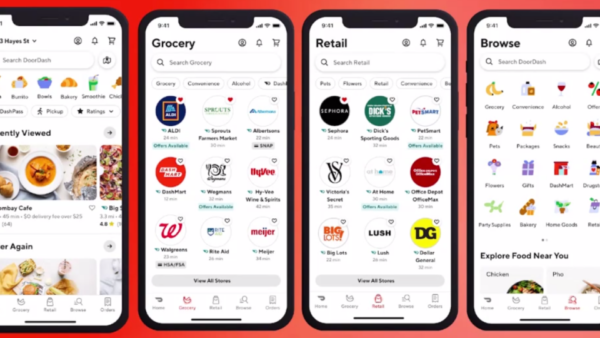How DoorDash is Growing by Advancing its ‘Local Commerce’ Mission


When DoorDash launched in 2013, it was all about restaurant delivery. Now, in addition to dinner from the local taco joint, you can order garden mulch from Lowe’s, mascara from Sephora and tequila for some margaritas to spice up Taco Tuesday, all in the same app. In fact, DoorDash’s reach has expanded so much in the past decade that the company has shifted its overall mission from food delivery to becoming the “local commerce app.”

Retail TouchPoints sat down with Fuad Hannon, DoorDash’s VP of New Verticals, to find out how the company plans to deliver on this expanded mission, especially when it means serving merchants that range from Fortune 500s to mom-and-pops — not to mention finding ways to deliver a great customer experience whether what’s being delivered is sporting goods, flowers or hot food.
Retail TouchPoints: It’s hard to go a day without seeing DoorDash in the headlines — how are you appealing to all these new retail partners?
Fuad Hannon: We’re thrilled with our momentum. We’ve got over 150,000 grocery, retail, convenience and alcohol stores on the platform now, up from 100,000 a year ago. What these retailers are all excited about is getting in front of an incremental consumer. DoorDash has over 37 million monthly active consumers and something like 17 million of them are DashPass subscribers.
The world we’ve built is one where you’ve got a real multi-category shopper. Over 20% of our consumers are now shopping across multiple categories, and that number continues to increase year over year. For example, yesterday I needed groceries and a new medicine ball. Within an hour I got groceries delivered and sports equipment from Dick’s, both on DoorDash. Then on Friday my wife got mascara delivered from DoorDash. What we’re really proud of and want to keep working on is having DoorDash become the local commerce platform, beyond just restaurants.
RTP: It’s a very competitive space though — what do you see as the key to winning?
Hannon: It’s not a really sexy answer, but I think it’s just about obsessing over the details. These are categories that are very, very difficult when you think about the end-to-end experience — from when you onboard a merchant to getting them live; making sure that their inventory is accurately represented on the platform and it’s easy for consumers to discover; to then fulfilling that order perfectly or substituting if something’s out of stock. It requires hundreds of small things to go really well.
The ethos of the company is [to focus on] getting 1% better every day. If we can execute every single day and make the experience continually better for our consumers, our merchants, our Dashers and our CPG partners, that will ultimately build a business that will address more and more consumers’ needs.
It is a really competitive space, but in terms of true local commerce — that is, getting every merchant on DoorDash — we’re still early in that evolution. We think we’re just in the first or second inning of that.
RTP: And it’s not always an either/or, right? There are many merchants who use DoorDash as well as your competitors.
Hannon: Certainly. We don’t think of these things as mutually exclusive. The DoorDash consumer addresses a different use case, it’s more of a need-it-now use case as opposed to a let-me-build-a-very-large-basket use case. But our combination of 37 million consumers that shop every single month — which is multiples larger than anyone else in the U.S. offering these type of services — combined with a consumer who is incremental, is super compelling to merchants.
RTP: How important are the big national chains to your success in this competitive environment?
Hannon: Since day one, DoorDash has been about selection, and that was an early position that DoorDash took that was different [from other players]. Even on the restaurant side, other platforms were like, “Let’s go get three of the sushi restaurants [in town],” and we said, “Bring all of them on the platform.”
That’s been core to our DNA, and it’s extended into the non-restaurant categories. Each merchant has different connections with their customers. For example, my wife loves Sephora and my sister loves Ulta; I don’t want to make the decision about which to bring on the platform. In pets we have both Petco and PetSmart. In grocery we have five of the top 10 grocers. Our point of view is, bring all of them on and allow consumers to choose. We’ve seen time and time again that the more selection we can bring onto the platform, the better it is for the overall consumer in terms of their ability to discover the entirety of DoorDash’s offering.
RTP: When I hear “local commerce” I think of the small shop in the center of town. How are you serving merchants all the way from major Fortune 500 companies to the local sushi restaurant?
Hannon: DoorDash started as a local commerce platform. For the first three or four years of the business we didn’t have any big enterprise restaurant merchants, it was all local restaurants. So it’s pretty core to who we are, helping enable small- and medium-sized businesses.
As we’ve moved beyond restaurants into additional categories, some of those categories skew more toward enterprise-level businesses. Grocery, for example, tends to be very enterprise, but even there we’re working on bringing on a lot of local favorites. As an example, I live in Minneapolis; we have everyone from Aldi, which is a big national grocer, to Hy-Vee, which is a regional grocer, and Lunds & Byerlys, which is Minneapolis-based. But in categories like alcohol or floral, there the majority of our selection is actually all SMBs.
We want to bring all these merchants on board, and what you have to build in order to enable that is very different. Some of these enterprise merchants are super sophisticated, they have rigorous data feeds to know what’s in stock, they have technology teams you can integrate with, and they have rosters of tens of thousands of SKUs.
But say you’re a local liquor store and you don’t have the technology to tell you what’s in stock or the staff to pick and prepare the order. No worries, we’ll send in a Dasher, the Dasher will shop on the consumer’s behalf and we’ll handle all of it on our end. We’ll go in and inventory the store, we’ll talk to distributors — it’s a pretty robust process. We’ve built our systems in a way that allows merchant A and merchant B to both be successful.
RTP: You make that sound easy, but it must be complicated to have that kind of variability in your tech.
Hannon: It’s tough, but if you want to become a local commerce app, you have to enable everybody to be successful. You can’t index on one or the other. And ultimately, consumers value selection more than just about anything. So if we’re missing their favorite florist, or if we’re missing their local liquor store, that’s not good enough.
The expectation that we have of ourselves is that we help all merchants grow their business, not just the big enterprise folks, and we help consumers discover their favorite local merchants. It does require a meaningfully different technology approach, and that’s what we’ve spent the better part of a decade building.
RTP: [Speaking of alcohol delivery specifically], do you expect Drizly’s demise to be beneficial to you in that category?
Hannon: We launched on-demand alcohol [delivery] in 2020 and since then we’ve added thousands of liquor stores to the platform across the majority of states. The thing with alcohol delivery relative to other categories is it’s the least penetrated online. It’s got something like a sub-5% online penetration rate, and there are a lot of rules and regulations you have to work through. There are certainly things that are happening in the competitive environment that are interesting, but the way that we think of it is that the real opportunity is the 95% that’s still offline.
RTP: How does the DashPass membership play into the company’s larger ambitions?
Hannon: What we’re trying to do with DashPass is make it the most loved and valuable online local subscription platform, so our focus has been to make this a no-brainer from a subscription platform perspective. It’s one subscription to power your life and get just about anything delivered, whether that’s a restaurant meal or you realize you’re out of bananas. DashPass customers are our most valuable, and merchants love them because their spend is typically higher than a non-DashPass user, as you might imagine.
RTP: The world of delivery has developed rapidly over the last few years. Where do you see it going from here?
Hannon: Local businesses power our economies. It can be easy to forget that because the Fortune 500s often have an outsized [piece of the] mindshare. Our vision is to keep bringing those local businesses online. There are still a bunch of restaurants we have to add to the platform; we have five of the top 10 grocers, but that means there’s five that we don’t have; there’s something like 50,000 local liquor stores in the country and we don’t have all of them — there’s still tons and tons of work to do on making sure that every single business is on DoorDash.
And at the same time [we need to] keep making the consumer app really responsive to who you are and what you need. We already have a bunch of that built in and you’ll start seeing more of that. For example, two consumers could be in the same city and the same time zone, but because one engaged with a healthier salad restaurant, they’re going to see a different experience than the other who ordered from Chick-fil-A last week.
What’s fun about the grocery and retail categories is it allows even more room for personalization. The way each person shops a store like Dick’s Sporting Goods is very different; that’s not the case for restaurants. At restaurants there’s no notion of gender or age or shoe size, so there are a lot of intricacies that start to come out [with these non-restaurant categories]. That’s where things get really interesting, and that’s probably the thing I’m most excited about — how can we continue making the app really responsive?
At the end of the day, you do all this work to bring on hundreds of thousands of merchants and hundreds of thousands of items and it has to all live on a pretty small screen. So how do you make it such that if you search for something, it shows the correct items? And then how do you fulfill that in a really high-quality way?
Imagine the differences in fulfilling a $100 order of sushi — small, really delicate, but not heavy — to ordering $100 of groceries to ordering $100 of mulch or $100 of beauty products from Sephora. Those are four totally different orders, and we have to build an operating model and a logistics platform that enables all of those kind of deliveries. We’re going to be busy for the next many, many, many years going through and executing all that.









